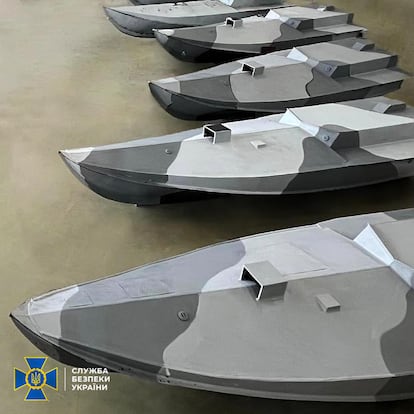From a truck bomb to a nautical drone: Ukraine details how it attacked bridge linking Crimea and Russia
The Kyiv security services claim responsibility for the sabotage, operations that demonstrate their ability to infiltrate enemy territory


There are drone attacks against facilities on Russian soil virtually every week, from Moscow’s financial district to military airfields or train stations. Until now, Kyiv has never taken responsibility for these sabotage operations. But something is changing in the country that has been battling an invasion by Vladimir Putin’s troops, whose aim is to erase the Ukrainian state.
The authorities in Ukraine have admitted to being behind the sabotage against the Kerch Bridge. In a show of unprecedented candor, Vasil Maliuk, head of the Security Services of Ukraine (SSU) detailed last week how they partially destroyed the only road connecting Russia with the illegally annexed Crimea peninsula in October 2022 and July 2023. Maliuk’s testimony is exceptional because it means that, for the first time, the Ukrainian military forces are admitting they are behind the attacks against Russian infrastructure, which until recently was a red line for their international allies. The latter have reiterated that they do not look favorably on Ukrainian military action either on Russian soil or in Crimea, which is a territory that, despite the illegal annexation by armed troops in 2014, Moscow consider an inalienable part of the country.
Maliuk’s remarks would appear to confirm that the United States and Kyiv’s European allies are becoming more flexible with their limits. Further proof of this is the go-ahead from Washington for the delivery of its F-16 fighter aircraft to Ukraine. The Netherlands and Denmark announced an agreement last Sunday to donate more than 60 of these US-produced fighter jets to the Ukrainian Air Force. Only six months earlier, the Biden Administration refused to give any authorization for the shipment of these planes for fear that it would lead to an escalation of tensions with Moscow.
Maliuk first spoke about the operations against the Kerch Bridge on August 15 on CNN. The head of the Ukrainian intelligence services confirmed that a newly minted nautical drone — according to his version, produced entirely by Ukrainian military engineers — hit one of the concrete pillars of the bridge last July, partially destroying the 19-kilometre (12-mile) highway built in 2018 across the Kerch Strait. The marine drone, dubbed the “Sea Baby,” was carrying 850 kilograms (1,873 pounds) of explosives.
Despite its innocent name, the “Sea Baby” has proven to be one of the most effective marine weapons of the war: also this summer, according to the SSU, the amphibious assault ship Olengorskii Gorniak and an oil tanker with fuel for the Russian army were attacked using these drones. What makes the attack on the Olengorskii Gorniak on August 4 more of a coup is that it took place beyond the Crimean Peninsula, in the military port of Novorossiysk on the coast of Russia’s Krasnodar province. The unmanned vessel sailed no less than 422 miles (about 680 kilometers) without being detected by the Russian fleet that has effectively closed the Black Sea.

In the video of the marine assault on the Kerch Bridge provided by the SSU to CNN, there is a detail that indicates a high level of Ukrainian infiltration in the Russian-occupied peninsula: in addition to the camera on the bomb boat, the video includes images of a camera installed on the bridge. In a subsequent interview with the Ukrainian outlet NV, Maliuk confirmed that they have access to cameras located on the infrastructure. The head of the security services did not specify more, but affirmed that they were able to follow the route of the truck bomb with these cameras. The explosion seriously damaged the bridge in October 2022, forcing months of delays in the supply of equipment for Russian troops on the front lines.
Maliuk’s account of the preparations for the sabotage using the truck could be the script for a movie: Ukrainian secret service agents hired a group of “Russian smugglers” to transport what were ostensibly 21 coils of polyethylene plastic into Crimea. What the carriers did not know is that a ton of hexane, an explosive hydrocarbon, was hidden inside each coil.
The Russian Security Services (FSB) reported at the time that the cargo that had initially left the Ukrainian city of Odesa, in August 2022, was transferred to Bulgaria, from where it continued to Armenia, then Georgia, before finally entering Russia. Twenty-two people have been detained in Russia, accused of complicity in the attack. Maliuk, however, claims they knew nothing about the operation.
The SSU hid the 21 tons of hexane inside the metal cylinders of the coils and chose the exact thickness of polyethylene that allowed the explosives to be concealed from the X-ray scanners that monitor vehicles as they begin to cross the bridge. Maliuk also revealed to NV that the truck had an embedded electronic system that maintained the GPS connection with the detonator for the explosives, despite the fact that satellite signal jammers are installed at the approaches to the Kerch Bridge.
The truck was detonated at 5.40 a.m. on October 8, coinciding with the passage of a train, causing the destruction of one direction of the highway and a segment of the railway line. The Russian authorities reported the death of five people, including the driver of the truck.
Two days later, on October 10, Russian President Vladimir Putin ordered a three-month bombing campaign against the Ukrainian energy grid. What the Kremlin announced as retaliation for the sabotage of the Kerch Bridge was actually a plan prepared months in advance, according to experts consulted by EL PAÍS, to leave Ukraine in the dark and without heating during the winter.
Summit to recover Crimea
The revelations about the attacks against the Kerch Bridge coincide with the third summit of the Crimean Platform this Wednesday. The working group was created in 2021 by Ukrainian President Volodymyr Zelenskiy, to gather international support to press for Russia to vacate the peninsula. At the 2022 event, the Crimea Platform featured a videoconference with the main European leaders and Secretary of State Antony Blinken representing the United States.
The third summit will be marked by mounting pressure on Kyiv to accept that one option to end the full-scale war is to cede part of the occupied territories to Russia. At the 2022 summit, the French President, Emmanuel Macron, the German Chancellor, Olaf Scholz, and Spanish Prime Minister Pedro Sánchez participated to underline that the EU remains firm in demanding that Putin return Crimea to Ukraine.
Sign up for our weekly newsletter to get more English-language news coverage from EL PAÍS USA Edition









































